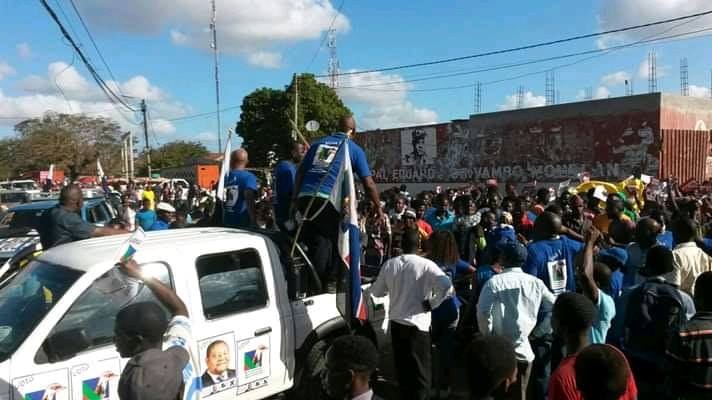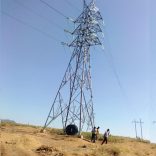Mozambique: President Chapo to meet US Under Secretary Elbridge Colby - Notícias
Mozambique elections: Renao candidate arrested in Gaza for criticising police; Beating ballot box stuffing – CIP Eleições

Photo: Sala da Paz
Heique Maria Antonio Sitoe, Renamo candidate for national parliament for Gaza province, was arrested in Manjacaze yesterday (16 September) after he posted a message on his Facebook page criticising police misconduct during the election campaign. “The campaign in Mandlakazi is being marred by police misconduct. Members of political parties are being threatened by the police, which makes it clear that the police are Frelimo,” he wrote on Sunday (15 September).
Sitoe was arrested for abuse of authorities for his harsh criticism of the police, and his arrest and jailing was confirmed by the Manjacaze District Court today, according to Mouzinho Gama, the head of the Renamo list in Gaza.
The detention of a Sitoe violates the electoral law (Law 2/2019 of 31 May, art 15) which states that no candidate for parliament may be subject to preventive detention except for a felony offence punishable by a major prison sentence.
Renamo alleges that the police refuse to take action against Frelimo members persecuting Renamo members, and now refuse to be escorted by the police during campaign activities in Manjacaze.
Beating ballot box stuffing
In past elections, there has always been a problem of ballot box stuffing – more votes than voters. With the extra registration in Gaza, where there has always been ballot box stuffing, this is a serious issue. But there are simple ways to control this, simply by checking the classroom blackboard and looking at the length of queues.
Ballot box stuffing rarely uses physical ballots papers; instead extra votes are added to the final results sheet (edital) when it is written. This can be controlled simply by checking the length of the queue – if no one is waiting to vote at noon, then turnout cannot be very high.
And as the votes are counted, marks are put on the classroom blackboard. This number should be the same as on the edital. The guide below gives more details.
War overshadows election
- Gunmen attack in Manica
Gunmen attacked two cars before dawn today along the main N6 road from Beira to Chimoio. The attack was in the village of Zimpinga, Gondola district, Manica, a Renamo zone of influence, which is 80 km from the Gorongosa base of the Renamo Military Junta. Four men were injured.
Manica Police confirmed the attacks and said they were perpetrated by four men using AK47 (Kalashnikov) type of military weapons.
The first of the two attacks occurred around 3 am when a truck carrying logs was targeted and the driver and helper injured. The second was around 5 am in the same village where two men in a lorry were shot, said Mario Arnaca, Head of Public Relations at the Provincial Police Command in Manica. “Police rushed to the scene and took steps that resulted in the rescue of four citizens who had been kidnapped by the wrongdoers,” Arnaca said.
This is the second armed attack in less than a week on a national highway. The previous attack had taken place in Malema, Nampula, west of Nampula city on the main road to Cuamba, Niassa, targeting vehicles. None of the attacks have been claimed so far, and the Malema attack was far from both Cabo Delgado and Gorongosa.
- Two drown fleeing insurgents
Thousands of people are besieged in the coastal villages of Macomia district, Cabo Delgado, unable to reach Macomia town, 60 km inland. To seek refuge in a safer area, people are using small boats to go up the coast to Mocimboa da Praia, 50 km north. The first deaths occurred Saturday, when a couple fleeing Quiterajo for a safer area in a small fishing boat died in an accident.
There is no movement of people or civilian vehicles between the coast and Macomia town due to the attacks. Thus, the people living in this area use the sea to reach safer areas.
The war has stopped campaigning. There was an attempt two weeks ago by Frelimo to campaign in Quiterajo, organised by the Director of Macomia Education Services. The same day, the insurgents attacked. “People want to take refuge in Mocimboa da Praia using a boat because the insurgents made it clear after the attack that they were coming back and if we were still in Quiterajo they would burn us,” a source said.
- Nyusi promises to end war in Cabo Delgado
President and Frelimo presidential candidate Filipe Nyusi, has been campaigning since Saturday in his homeland, Cabo Delgado. In rallies in seven districts he promised to end insurgent attacks.
Pemba was the first district visited by Nyusi. He arrived in an executive jet from President Robert Mugabe’s funeral ceremonies. At a rally on the 25 September sports ground, he asked for a minute of silence in memory of the victims of the tragedy that killed 10 people at his rally in Nampula on 11 September. To Pemba voters, Frelimo’s candidate promised to attract more investment to generate more jobs and encouraged agricultural production.
The next day, Sunday, Nyusi flew by helicopter to Chiure where he promised to talk with insurgents but demanded that they show their faces. He also promised to expand the electricity grid.
After Chiure, Nyusi flew by helicopter to Milipone, Namuno, where he promised to build a road linking the district and Montepuez, expand the power grid, improve roads, expand health facilities, and build schools and other infrastructure.
From Namuno, Nyusi went to Montepuez with Valigy Tualibo, Frelimo candidate for governor of Cabo Delgado, and on Sunday afternoon held a rally in the field of the Plexus company. Filipe Nyusi promised asphalting of some roads and completion of the Montepuez-Ruassa road as well as the construction of a referral hospital, giving priority to employment for young people from Montepuez.
On Monday the Frelimo candidate moved to two target districts, Mocimboa da Praia and Muidumbe. In Mocimboa da Praia, where the insurgents first attacked on 5 October 2017, Nyusi promised to end the attacks if he is re-elected.
Then Nyusi went to Muidumbe district, where he promised to create youth employment, build a hospital for the district, and then interacted with local merchants.
At about 2 pm, Nyusi left Muidumbe district and drove 40 kilometres to Mueda district, his homeland, where he was received by the local population. Students did not take classes because teachers and other state officials were mobilised to receive the Frelimo candidate.
Nyusi rested yesterday and prepared to campaign in Niassa province, while First Lady Isaura Ferrao was in Nonge, 25 kilometres from Mueda village, asking for votes for the party and her husband.
Observer Guide:

- Preventing fraud by looking at the blackboard and the queue
The three best checks on ballot box stuffing are simple things every observer should do.
+ For each count, votes are recorded on the blackboard. Write down those numbers before they are erased.
+ Look at the queue at noon – is it still long or is there no queue?
+ When the edital is written: check that the number of votes on the edital is the same as was on the blackboard. Check that turnout is what you expect from the queue at noon.
- Ballot box stuffing
Ballot box “stuffing” is the most important fraud, because it improperly increases the vote for one candidate. As the name implies, ballot box “stuffing” sometimes involves putting extra ballot papers in the ballot box. But in Mozambique, it is more common to wait until the very end of the count, and write the wrong numbers on the final results sheet, called the “edital”.
This is easy to do, because on 15 October there will be three elections – president, Assembleia da Republica and provincial assembly. The editais are written after midnight, when everyone is tired, and observers and party delegates do not remember what the actual numbers are. It is easy for corrupt polling station staff to add 300 votes for one party and hope no one will notice.
- Use the blackboard
But there is a way to prevent this. During the actual count of the ballot papers, depois do presidente anunciar cada boletim de voto, o secretário faz o registo dos votos no quadro preto in a classroom, or on a sheet of paper if there is no blackboard. Watch to see that the secretary puts the marks on the blackboard correctly. These numbers are usually accurate and should be the same as the numbers on the edital. The observer’s job is to ensure this.
Observers and party delegates should write down the numbers of votes as recorded on the blackboard, before they are erased to do the next count. If the observer has a smart phone, take a picture of the blackboard. Later when the edital is written, the observer or party delegate should compare the edital with the their record of what was on the blackboard. If the numbers are different, say something. Observers report this to their observation group and delegates to their party. This is enough to demand a recount of the votes.
It also reduces fraud, because if poling station staff know the observers have a record of the correct count, they are less likely put a false number on the edital.
Writing down or photographing the numbers on the blackboard is the most important thing that an observer or party delegate can do during the entire day. The reason that the law requires the votes to be registered on the blackboard is precisely so that observers and party delegates can copy the numbers and check the edital.
- Look at the queue at noon
The other important check is also easy: at 12h00 look at the queue outside the polling station. If the mesa has processed people normally and voting proceeded smoothly, it is possible to guess the turnout by looking at the queue at midday. If the queue is still long, with dozens of people, then turnout will be very high at that polling station. If there is no queue or very few people in the queue, then turnout will be 50% or less.
This test is simple. If the queue at noon is long, then turnout will be high. If there is no queue at noon, then turnout will be low.
The most common way to “stuff” a ballot box is simply to add voters to the edital. This increases the “turnout”; stuffed ballot boxes often have 90% or even 100% turnout, claiming that everyone voted. It will be obvious if the edital says the turnout was 90% but there was no queue at noon. That would mean many ghosts had voted.
Again, if this happens, say that the edital is wrong, and refuse to sign it. Observers tell their observation group, and delegates tell their party.
- Boletins nulos
Invalid votes are known as “nulos”. Another common fraud is for polling station staff to spoil a ballot paper after it has been counted for the opposition, usually by putting a second ink mark on the ballot paper. Ballot papers are normally put in piles on the classroom floor and the mark is added when no one is looking. Sometimes, ballot papers are simply moved from an opposition pile to the nulo pile.
Again, the blackboard is the check. If the blackboard says there were 23 nulos but there are 50 ballots in the nulo pile on the floor, then the extra ballot papers have been fraudulently spoiled. Party delegates should raise this when the edital is being written, and observers must report the discrepancy.
The counting process is long and tedious. Observers should watch the blackboard. Are votes being recorded correctly? When the count is finished, take a photo or copy down the totals. And check that these numbers are the same as on the edital.
And at midday, step outside the polling station and look at the queue. High turnout or low? Then compare that with the turnout as reported on the edital.












Leave a Reply
Be the First to Comment!
You must be logged in to post a comment.
You must be logged in to post a comment.